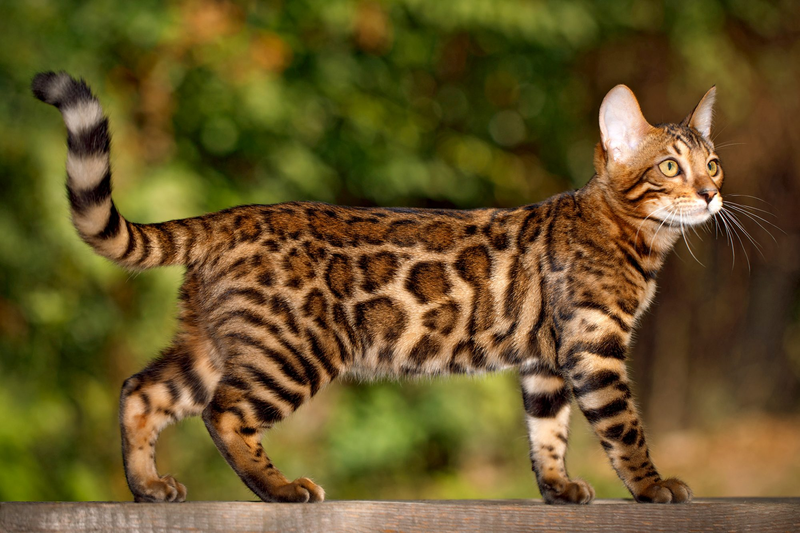Bengal Cat Information and Personality Traits

A large, athletic breed, the Bengal attaches closely to her people and is a loyal friend with a sweet personality The Bengal’s size and muscle truly resembles a wild cat’s appearance.
Weight range:
Male: large: >12 lbs.
Female: large: >12 lbs.
Eye color:
Blue
Expectations:
Longevity Range: 9-13 yrs.
Social/Attention Needs: High
Tendency to Shed: Low
Coat:
Length: Short
Characteristics: Glossy, Smooth
Colors: Brown, Seal
Pattern: Tabby, Ticking, Spots
Less Allergenic: No
Overall Grooming Needs: Moderate
Club recognition:
Cat Association Recognition:
ACFA , FIFe, TICA
Prevalence: So-so
The Bengal truly does remind you of a wild cat in appearance. She is a large cat and is heavily muscled, although the boning may be surprisingly light for her size. When you see her, everything about her appears large, massive and thick. The only thing that is moderate is the medium leg length.
The Bengal has a large, triangular shaped head. She has a thick neck, large feet and a thick tail. The patterns are generally limited by the infusion of the Tabby gene in the original hybridization. A brown-spotted Bengal does look like a feral cat. The spots on the coat should not line up in rows, but should appear randomly placed.
The coat of the Bengal is short and may even feel a little rough naturally. The coat is easy to care for and does not mat.
Personality:
While many people consider the Bengal to be a wild cat that only pretends to be domesticated, the breed is actually very sweet and loving. The Bengal attaches closely to her people and is a loyal friend. As a large, athletic cat, the Bengal needs to run, jump, and romp to be contented. She is a curious and alert cat.
Living With:
The Bengal is an active cat who is extremely athletic. If given adequate room for exercise, she can maintain her own weight without too much difficulty. The Bengal absolutely must have the ability to run and exercise freely. She is easy to keep groomed and enjoys her grooming.
History:
The beauty of wild cats has always been attractive to people, so efforts were made to breed one of the wild cats to a domestic cat in order to have a wild-appearing but gentle-tempered domestic cat. To this end, the first hybridization of the Asian Leopard cat and Domestic Tabby cats were undertaken in the early 1960s in the United States. This breeding program was suspended temporarily and then restarted in 1981 by Jean Mill and Dr. Willard Centerwall.
Despite many obstacles in producing this hybrid, a wild-looking cat who achieved domesticity was the ultimate result of the breeding program. Since the wild cat used in the foundation of the breed was the Felis Bengalensis, the name of the breed became the Bengal.
The Bengal began as a controversial breed, and, to some degree, remains one today. Some concerns are that more wild cats will be used in domestic breeding, and that the feral part of the Bengal cannot ever truly be bred out of the domestic cat. However, this may not be a major concern because of liberal outcrossing with domestic cats, and because cat registries prohibit having show Bengals be too closely related to their wild ancestors.